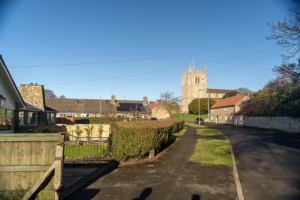Life at the Kirton in Lindsey Gas Works
by Mr. D R Odlin, the last engineer at the works and served nearly 40 years
There were two 8 foot high by 6 feet wide gates on large hinges made out of wood, which were very strong. An 8 foot high wall, two brick thick, going down the Ten Foot nearly to the gasholder. The house was on the right entering the gates and the Retort House on the left. The house had two large rooms downstairs, two bedrooms, a small kitchen, a bathroom and a porch but there was only one door into the house.
The room on the right was used for an office. Gas lights were on new bridge switches, either batteries or pilot lights. Water was on tap from the tank in the orchard. This tank was filled from a well in the yard, a pump belt driven from one of the engines.
A shed down in the yard was used as a washhouse. In it was a hand-pump for water, gas light, and gas wash-boiler.
When you went into the orchard, there were three condensers on the right-hand side of the coal shed, on your left-hand side as you went through to the orchard door. When you got through the door on your left was a concrete base, on three iron legs about twelve feet high, with an iron tank on top, holding about three to 400 gallons of water. On the side from a float was an indicator to let you know when the tank was full.
The Retort House was two beds of retorts, one was a four bed, the other was five. Later the four bed was made into six. I would say the Retort House was about 25 feet wide by 35 feet long and 25 high. There was a large sliding door on the right-hand side wall, where coal was neatly stacked. Against it, a water tank stood in the middle, against the wall iron, which held about two hundred gallons of water. There was also tap water from a tank in the orchard. In the front of each furnace was a pit about 6 feet deep by 6 feet long by 6 feet wide. The pit had two heavy iron checked plates on it, with a support down the centre. In the pit was the furnace with two iron doors on the inside. There were about three iron plates holding the white-hot coke water, which was running onto these plates all the time, a steady trickle. You could see that from up above, so they did not get too hot. In the corner of the pit was a hole. This was used to keep about three buckets of water to put onto the hot clinker when you clinkered the fire and to get down in when you threw the water on the hot clinker or you got scalded.
In the pit were the plates to adjust the primary and secondary flues. These were set up by the firm who put the new retorts in, but the air to the furnace we set up to get the best results.
We had a rake, which we cleaned the flues out with, but we always set them back up in the same place as they were. The furnace was always filled up with the first retort you opened in the morning, you raked a bit of hot coke forward then got the long shovel, put gloves on your hands and put the hot coke in the furnace until you had got it full. The rest of the other retorts were pulled into a skeleton barrow and taken up the yard. You left some in on the floor in the centre to keep the furnace going when you required it. You had to keep throwing water on the hot coke from the tank. The retorts were charged one at a time until you had completed them. You had a straight handled shovel and charged the bottom retorts with the coal against the wall. The others you charged out of a two-wheel barrow. As a rule, after you had done this job, you were ready for a break.
After the break you checked to see if everything was alright. Sorry to say, I missed the starting of the gas engine. After you had charged the first retort, you then put weights on the compensator to pull the gas from the retorts. The water gauge told you what pull you had on.
You had to keep filling the engine up with oil. The engines were water cooled from tanks outside. You would then take the plate off the pit and bucket the water out of the pit into the tank. The bucket had a rope attached to it.
All the coal had to be brought in by wheelbarrow and stacked against the wall. The two-wheel barrow was also filled for the next shift. I forgot to say when you had taken the water out of the pit, you had to throw the clinker up into a wheelbarrow and take it up the yard. All the time you had to keep your eye on the fishtail light to see it kept at a constant temperature and book your gas made every hour and the total when you had completed your shift (about 2000 cu feet per hour).
We only had the need to run one furnace at a time then. When we had them repaired with new retorts, we could carry on. Sometimes when the long ducks to the furnace and all around the retorts were blocked with flue dust, we threw a bucket of water into the furnace, after opening the door, then closing it in extra quick time. This was with the help of someone else. This was not done very often. We had a special rake to clean the flues. We also had a spy hole in the furnace, about two foot off the ground, in the centre with a plug in about 4 inches diameter round. You took it out and by putting a small lump of coal just inside it, which got it on fire to burn right. To let you know it was set up right, it would pull the flame in, then let it come out. This could be done by adjusting the primary and secondary flues, also the air slides on the furnace.
Sometimes the pipes taking this gas away from the retorts got blocked, so you had to open the retort doors after first lighting, then put an auger up the pipes or if that would not clear them, you had to get a ladder, which was there for the purpose. You could take caps off up on the hydraulics and put an auger through. You did not require your best clothes, but we had shirts and work clothes for the job. We also had a washbasin and hot water to get washed before we went home, because you were wet through and dirty.
The gas went from the Engine House to the Scrubber, which never worked whilst I was there, so the valves were turned off. It was by-passed, then sent through the washer, which was an oblong cast tank with two windows in. You could see the water bubbling about as the tar was taken out of the gas. Two pipes were letting water run in very slowly. All the time you were making gas, you would open a valve then the tar would run into a small well, then across to the tar well. After the gas left the washer, it went to the purifiers. We had two – one or the other we could turn off when we put clean oxide of iron in, which, when the gas went through, it took all the sulphur and naphthalene out. The oxide was on two sets of grids made of tough wood, which, after the oxide had done its job for quite a time, got hard. The lid of the purifier, which was about 8 foot by 8 foot by 3 foot deep and in a water seal could be lifted off by a pulley and hook. The lid had a ring on and the pulley was on two girders and cross member a permanent job. The purifier was about 5 foot deep. The oxide had to be shovelled out on a head and we had another man to help with this job. He also spread this on the ground after first breaking it up and putting it through a riddle (large one), it was like sand. It was then spread out on the top of where an old gas holder used to be. The air got to it and cleaned it by the time the next purifier was ready and could be used again and again.
After the gas left the purifier, it went through the station meter. This was booked every hour, then totalled at the end of the shift. The meter was partly filled with water so this had to be checked. There was a clock in with the meter indicators which required winding every week. It was always spot on, and was good company when you heard its loud tick. Also in the Meter House was the station governor, which controlled the district pressure, which was 5 foot water pressure. You kept an eye on that too, to see that there was no fluctuation. If there was, you would check the district siphons.
When I first started with the gas company, we had the Manager, who had the City and Guilds for Gas Fitting. He was called Mr W Gumrill. He was a good manager. Then another lad, W Clifton, who I was friendly with, was asked by Mr Gumrill if he would like to learn gas fitting or the works side. He said he would like the works so that let me go out on the district learning the fitting. In those days, the cookers only had a tap for the oven. You turned them a piece straight up or across to rise and lower the flame, grill and four gas rings. There weren’t many other gas appliances although some houses had a geyser for hot water.
When the war was on, a fitter from Redhill was helping out at Kirton. He was called up for the forces. Then so was the manager, so we had an older man who came to take over, Mr P Keogh. He was Irish but did not drink or smoke, very nice man. The gas make started to go up, so he got two new men, Mr A Marsh, who started to help in the yard and dig the trenches in the street and Mr Brooks who did the shift on the stoking. After a few more years, Mr Keogh moved and we got Mr W Young, then W Clifton left, so we got Mr A Bullivent. Mr Marsh retired so we had a Mr G Bullivent. There was a space between all the changes.
After the war, or soon after, a Mr H Christion came as Manager. He also got another stoker, Mr R Grundy (nationalised) soon after. Mr Christion left. Mr Grundy and myself carried on for a number of years. Mr A Bullivent got another job, but he had to move to Scunthorpe, which he did for a number of years. I was just short of forty years.
I then went to the steelworks but after about 4½ years I was made redundant, so I thought I would make a few notes. The gasworks have now been taken down but the gas made at Kirton was about 4 million cubic foot a year when I started. When I finished it was 10 million cubic foot. We had electric motors installed in larger retorts. The works was cleaner and working much better than when I started. I was very sorry to leave it.
Excuse these notes, but I left the gas board about ten years ago and my memory is not so good, but I thought a lot of young people would be proud to say one day “We had our own gas works” and also know where it was.
KIRTON IN LINDSEY GAS LIGHT AND COKE CO LTD
1. Retort House
2. House for the manager
3. Meter House (eight sides)
4. Meter for Station
5. Station Governor
6. Three condensers
7. Engine House and compensator
8. Engine House
9. Boiler to keep the frost off the Gas Holder
10. Water tank
11. Water pump
12. Tar well
13. Tar tank
14. Tar pump
15. Washer
16. Scrubber
17. Gas Holder 25,000 Cu feet spiral guided one lift
18. Pipework from boiler to holder flow and return (2”)
19. Oxide bed
20. Riddle for oxide of iron
21. Rakes for the retorts
22. Sliding door on retort house 10 feet high, 10 feet long
23. Water well
24. Water cistern
25. Wooden floors in the house
26. Purifiers (2)
27. Wash-house or shed
28. Windows in the house (7) – kitchen – 1, bathroom – 1, porch – 1, back of house, two looking out on ten foot – 4
29. Stairs
30. Porch with window looking onto Works
31. Kitchen
32. Bathroom
33. Doors
34. Plates over well and cistern
35. Coal
36. Water tank in retort house to put water on hot coke
37. Valves
38. Trees
39. Orchard
40. Pits to furnace
41. Retorts
42. Coal Shed
43. Fitting Shop
44. Water gauge
45. Fishtale flame
46. Gates
47. Two wheel truck
48. Wall
49. Ten foot
50. Clinker
51. Coke
52. Retort House chimney stack from furnace
53. Concrete
KIRTON IN LINDSEY GAS WORKS, CORNWALL STREET
Two 8’ wide very strong wooden gates hung on very large hinges from a two brick thick wall. The house was on your right, having two large rooms downstairs, two bedrooms, a kitchen, a bathroom and a porch with the only door to the house. The room on the right was used as an office. Gas lighting naturally on newbridge switches, either batters or pilot lights. Water on tap from the tank in the orchard. This tank was filled from a well in the yard by a pump belt driven from one of the engines.
A shed down the yard was used as a wash-house. Inside was a hand-pump for water, plus gas lighting and a gas washboiler.
You entered the orchard. There were tree condensers on the right and a huge coal store. As you left the orchard through a door on your left, there was a concrete base. Stood on this was a unit with three iron legs about 12’ high. On top was an iron tank, holding three to four hundred gallons of water.
In the retort house were stood, as you can see from the drawing, two banks of retorts, a six bank unit and five bank unit. The retort house stood about 25 feet high, 35 feet long and 25 feet wide. There was a large sliding door on the right hand side wall. Coal was kept neatly stacked. Also this building housed a 200 gallon water tank.
In front of each of the two furnaces there were pits, search pits being about 6 foot deep, 6 foot long and 6 foot wide. They had heavy iron doors. In the pit was the furnace front with more iron doors on. We had a rake that was used to clean the flues out with, these were always kept in exactly the same place.
The furnace was always filled up with the first retort one opening in the morning. This was done by downing gloves and using a long handled shovel, placing hot coke in the furnace until the furnace was full. The other retorts were drawn into a skeleton barrow and taken away, after leaving a small quantity on the floor to use later as required, to re-charge the other retorts again. After you had done this job, you were ready for a break.
After the break, you checked to make sure all was well.
The gas engineer was started after the first retort was charged and weights put on the compensator. This engine pulled the gas from the retorts. A water gauge indicated the pull developed by the motor. The machine had to be frequently topped up with oil. Outside tanks full of water kept the engine cool.
A plate was removed from the pit and the water bucketed out. The bucket was on a long rope. All the coal was bought in on a wheelbarrow and stacked against the wall.
Also the climber was taken out of the pit and put in a wheelbarrow to be taken out into the yard.
All this time, a fishtank light had to be watched to make sure it kept at 500cu and book the gas make every hour and the total at the end of a shift used to arrange 2,000 cu feet per hour.
We only had need to run one furnace at a time then. When we had then repainted at a new retort we could carry on.
Sometimes when the long ducts to the furnace and around the retorts were blocked with flue dust we threw a bucket of water into the furnaces and by opening and closing the furnace door very quickly with someone’s help, the steam would shift the dust.
KIRTON IN LINDSEY GAS WORKS
It is not known exactly in which year gas started to be supplied in Kirton, but in 1856 it was sold to the private company, Redhill & Reigate Light & Coal Co Ltd for the purpose of installing street lighting and making more gas available in houses.
The head of this gas works in the early years was a Mr Little, appropriately known as ‘Gassy Little’. He asserted his status as head of this public utility by wearing a silk hat and frock coat on his daily visits to the Town Hall. He bitterly resented the attention of small boys who frequently followed him up the hill singing ‘Lead Kindly Light’ and making ribald remarks as to the quality of the gas. He had all the tools marked with his name, eg the stilsons or grips which were used for tightening pipes, etc.
Managers who followed Mr Little were Messrs Hobbs, Gumrill, Blackley, Keogh and Christian.
Improvements were anticipated under this new company, but things did not change too much for some time. In many houses, it was only supplied to downstairs rooms at first and there was no street lighting.
By 1866 the inhabitants of Kirton were starting to complain bitterly about the lack of both quality and quantity of gas in the town. A report at the time in the Rutland and Stamford Mercury newspaper in February of that year talked of such impure and smelly gas that it was sometimes impossible to remain in a closed room where the gas was burning, however tightly they fitted the pendants and some people were threatening to stop their supply of gas unless it could be made purer, especially as they maintained they were paying prices that should enable the gas company to secure the best quality coal.
Later that year at a meeting, it was proposed that street lighting should be installed and as that increased business, perhaps the price of home lighting could be reduced. However, again, by November of that same year, we again find another report of the inhabitants complaining and it looks as though the Directors and shareholders would soon have to act. Hopefully, the gas supply to the town did gradually improve after that.
In 1892 at a meeting of the shareholders, the gas company was voluntarily wound up. In a newspaper report in the Hull Times of 21st May 1892 it stated that:
“A meeting of the Shareholders was held on Wednesday at the offices of Messrs B Howlett & Son, Solicitors. Dr C F George was in the Chair and Messrs S Picksley, C Smith, J W Hill, Mrs Usher, Mrs M Hill, Miss M George and Miss Gertrude Hill were present.
Mrs Usher proposed that, in accordance with the previous meeting, the Company be wound up voluntarily according to the Companies Act and that
Mr V P Palmer be appointed Liquidator. Mr Cornelius Smith seconded and it was carried unanimously”.
The gasworks remained in private ownership until 1950 when it was nationalised, when it became known as the East Midland Gas Co.
In 1955 the production of gas in Kirton was discontinued, but Mr D Odlin as appointed Resident Fitter and lives in the house on the site to this day.
1893 – Electric light installed at corn mills – CMM
INTERVIEW OF DR C F GEORGE BY NEWSPAPER REPORTER IN 1902
Dr George recalls that the pump in the Market Place was surmounted by a gas lamp supplied by the gas company, who supplied the gas free so long as the people would light it on dark nights.
One night the iron pump was broken. A neighbouring resident was returning from the Redbourne races and was thrown out of his horse and cart and injured. Dr George was called to attend to the man. In the meantime, the horse had run away with the cart and later careered across the Market Place, crashing into the pump, which fell with a crash and was broken. The horse was eventually stopped opposite Boon’s shop.
The ornamental pump in the centre of the Market Place was given to the town by the Gas Company and they also gave and mounted a lamp placed on the top. They gave free gas so long as the people would light it on dark nights.
Eventually the local people did not trouble to light the lamp.



